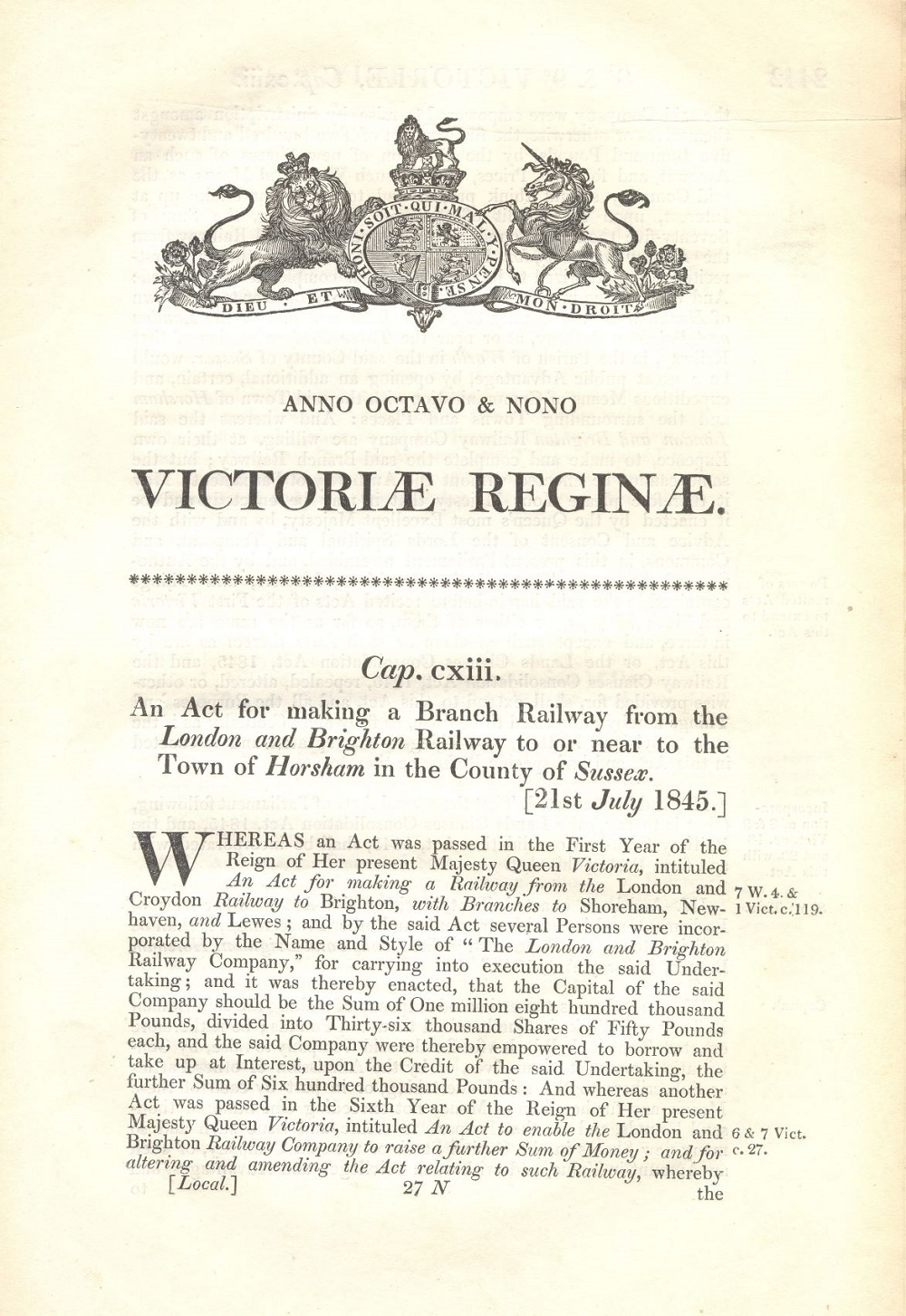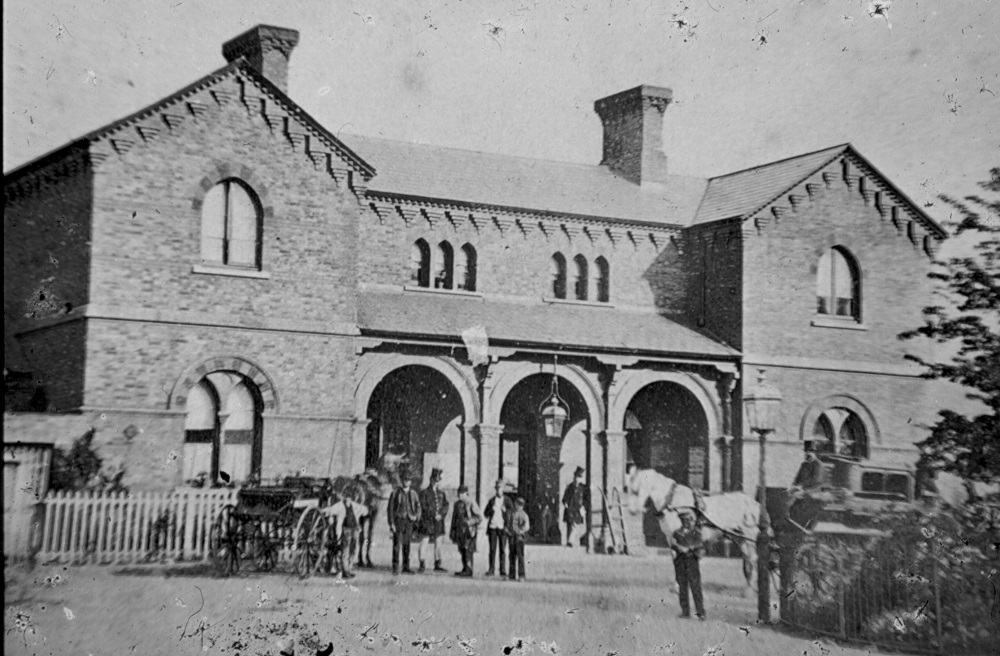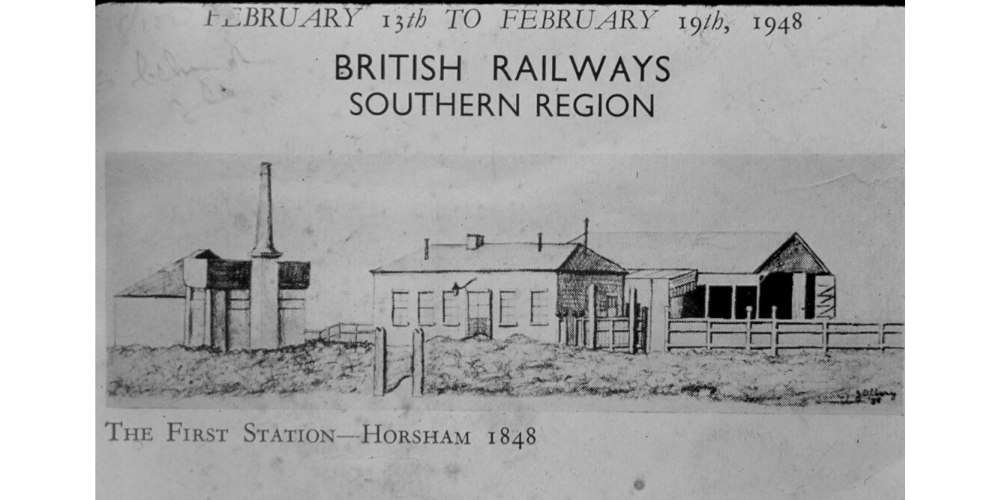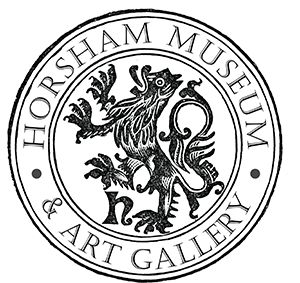
Today the news is all about the train stations across the country preparing for the return of those who are unable to work from home and cannot use a car, bike, or walk to work. Given this increased interest in rail travel let’s look at how the train came to Horsham; the first place in the District to have a train station.
George Stephenson’s ‘Rocket Trials’ at Rainhill on the Liverpool & Manchester Railway occurred in October 1829. The first steam-driven passenger railway opened in 1830 and the general form which public passenger railways were to take was settled when this line opened in September 1830.
Unusually for Horsham, the town actively promoted the coming of the railway. In 1834, plans were put forward for the “Grand Southern Railway”, better known as Stephenson’s Railway, to connect London to Brighton via Dorking, Horsham and Shoreham.
According to Henry Burstow, who recounted the events in 1911, there was “much excitement” in the town in 1834. A “Railway Hotel” was built for the prospective line, though it never came to anything. The building is now a church that still stands in Brighton Road, next to the Tanner’s Arms, and opposite the junction with Elm Grove.
The first railway station
In 1845, due to the various demands of the railway companies, an Act of Parliament was passed for the building of a railway line from Three Bridges to Horsham, and no further. Why? The act went on to give what management speak today would refer to as a “minimum service level agreement”, namely that the trains were to stop:
at least twice in every Day on their Passage from the said London and Brighton railway to the said Town of Horsham, and twice on every Day from the said Town of Horsham to the said London and Brighton Railway.
It went on to say that the railway had to be constructed within 3 years of the act being passed, and then it set out the maximum charges in some detail. First class passengers would pay 3d per mile, Second-class 2d per mile and Third-class 1 1/2d per mile.
On Monday morning 19th February 1848, the new line opened for traffic. The station terminus here was but a little plain structure standing about midway between the present station and the Railway Hotel. A great many people went up to see the departure of the first train. There was no ceremonial send –off, but there was a public dinner at the King’s Head in the afternoon at which Mr Padwick presided. I was present when the first train steamed out of the station. It was not a very long one, but as the first journey was free of expense to travellers it was very full. Some of the cars, were covered and some were open; these latte, the third class, were at once named rubbish carts.
Henry Burstow recounts the memorable day in his Reminiscences of Horsham.

The second railway station
Horsham was connected by a single track to Three Bridges from 1848. Some 9 years later, on 10th August 1857, an act was presented to Parliament for the extension of the London and Brighton South Coast Railway from Horsham to Pulborough. The act then sets out a number of very specific features which affected the topography of the town and station:
- The new line started 130 feet north east of the current passenger platform.
- That the Crawley and Horsham Turnpike road, New Street Road and Station Road were altered to make way for the railway.
- The railway could build a bridge instead of a level crossing on the Horsham and Brighton Turnpike Road by raising “the Levels of the said Railway Nine Feet, and to lower the said Horsham and Brighton Turnpike Road Eight Feet, and to construct a Bridge over the said Turnpike Road with a Span not less than Thirty-five Feet, and with a clear Headway of not less than Fifteen Feet throughout the Span and the Inclination of the approaches to be not less than One in Thirty”- that is building the East street Iron bridge
- They also specifically agreed to build, and maintain forever, a 9 ft-wide bridge over the railway that runs through the “Kitchen Garden” of Robert Henry Hurst. The approach to the bridge to be not steeper than one in twenty.
The company had two years in which it could make compulsory purchases, and four years in which it could build the railway, before the provisions of the act ceased. The railway was completed just in time and opened on 10th October 1859.
As for the station, the old wooden railway station closed and a new brick built station was built on the other side of the Horsham to Crawley Turnpike road. The station was a rather grand affair, with its two chimneys standing at two stories high, mimicking the medieval aisled houses with two wings between which was a canopy. The windows were arched in a gothic style that was popular at the time. Horsham station was a destination; you arrived and left in style in one of the largest buildings built in Horsham. The story then continues as the railway network expanded across the District.

Extending the importance of Horsham
Horsham may now challenge any town in England for perfect railway and communication. Hurst (1868)
At the same time the aforementioned act was presented to parliament in 1857, another plan was put forward; the Shoreham, Horsham, and Dorking Railway. The prospectus was for 17,500 shares at £20 a share realizing £350,000 in capital. A 30 mile railway linking Shoreham by Horsham to Dorking was proposed, connecting Steyning, Henfield, West Grinstead, Cowfold, Capel, Ockley, Newdigate “and a large tract of country abounding in gentlemen’s residences” as well as opening up Shoreham harbour “of great extent and capacity” and its hinterland.
In addition to being able to take agricultural produce to market more easily and cheaply, this line would link with another new line (authorised by Parliament in July 1857) linking the Wimbledon, Dorking, Epsom and Leatherhead railways, as well as a proposed line between Leatherhead to Dorking. If all went to plan it was argued that “a through line of communication from Shoreham to the Waterloo Station London 51 miles in length, will be established.” Unfortunately this did not happen until ten years later in 1868.

On 6th August 1860 the Horsham and Guilford Direct Railway Act was passed, setting out plans for the building of a railway to Guildford at a junction with the Mid-Sussex Railway in the parish of Itchingfield (Stammerham). In fact, it did not open until 1865. This act was followed with the passing of the Horsham to Dorking and Leatherhead Act on the 17th July 1862. The railway opened in 1867, five years after the act had passed. The following year the line to Shoreham opened.
The sense of pride in the town, and the idea that Horsham was now being connected to a wider rail network, rather than being a “dead end” or a terminus, possibly encouraged the publication in 1858 of “Ten views in and around Horsham with a short descriptive sketch” which would be republished 11 years later as “The Strangers Guide”.
Published: 12 Jun 2020
